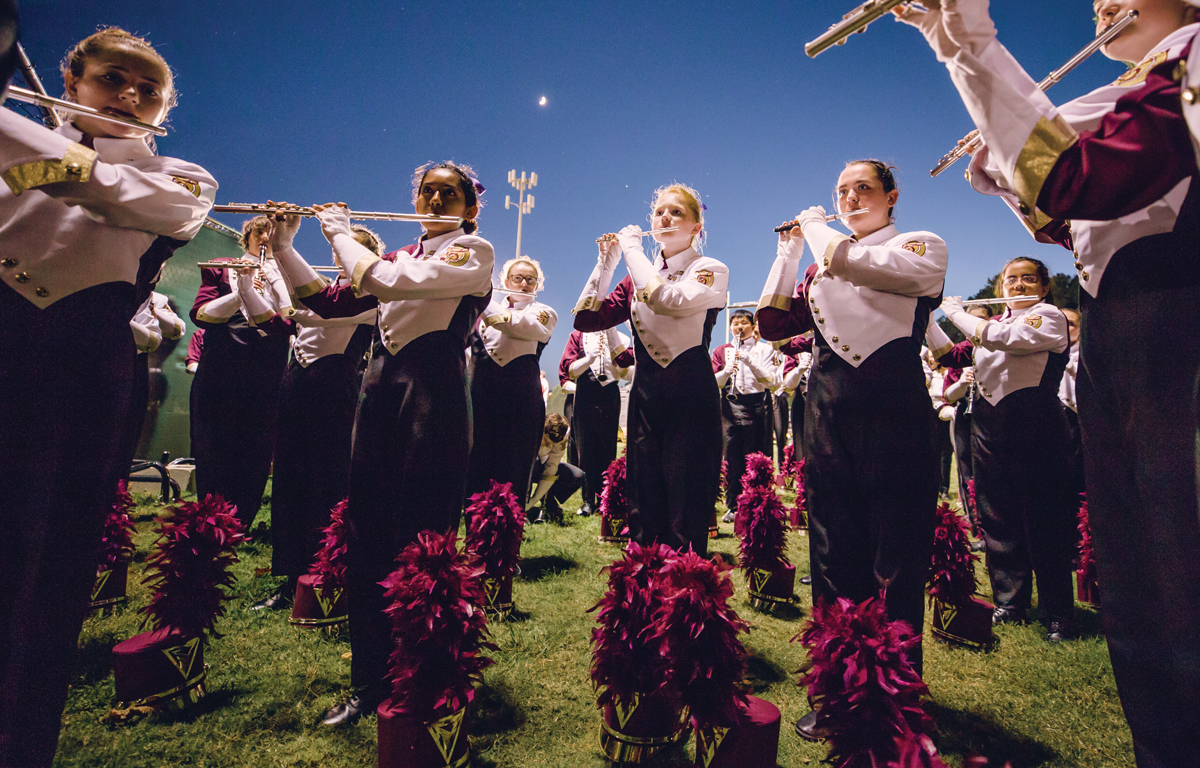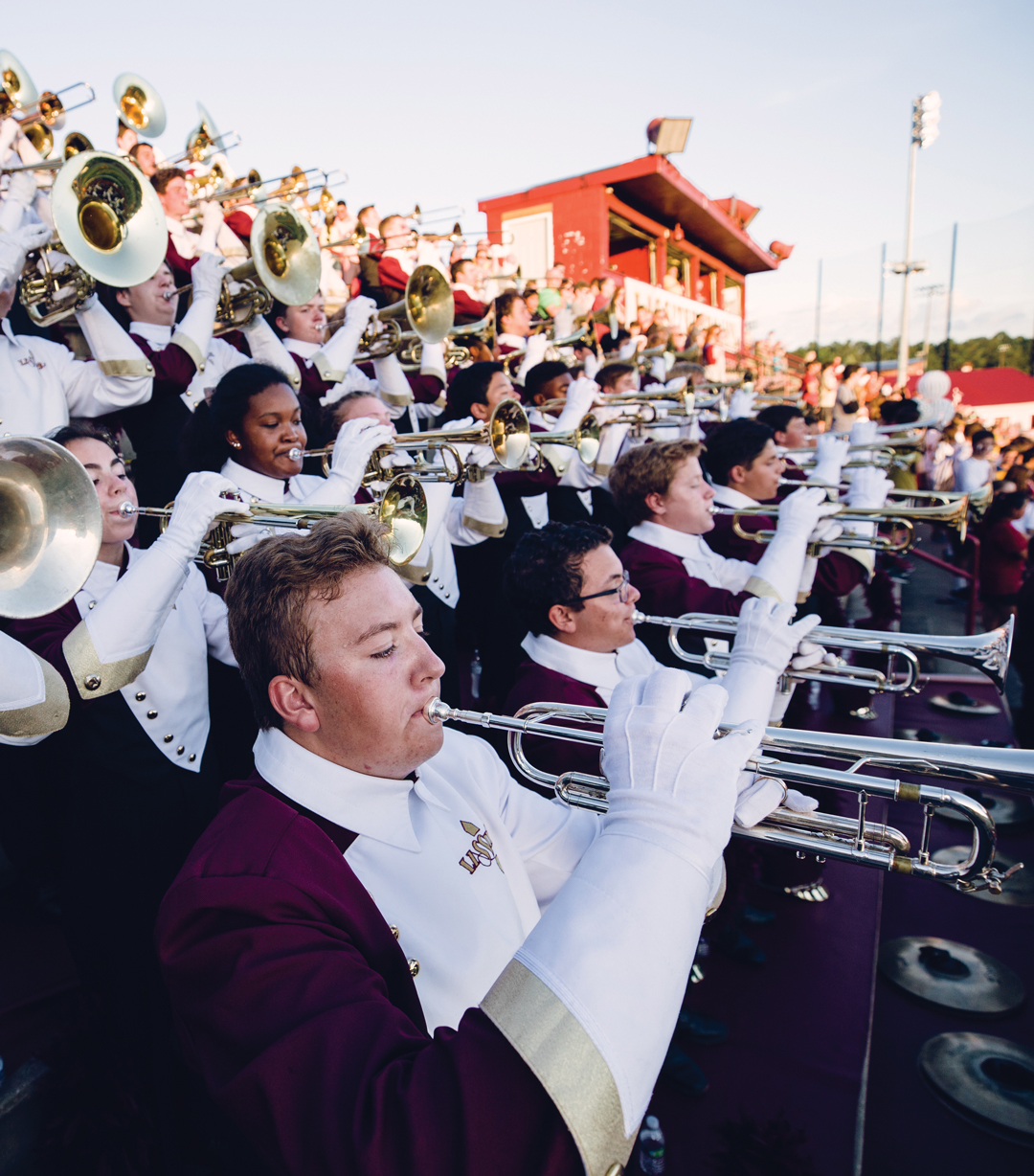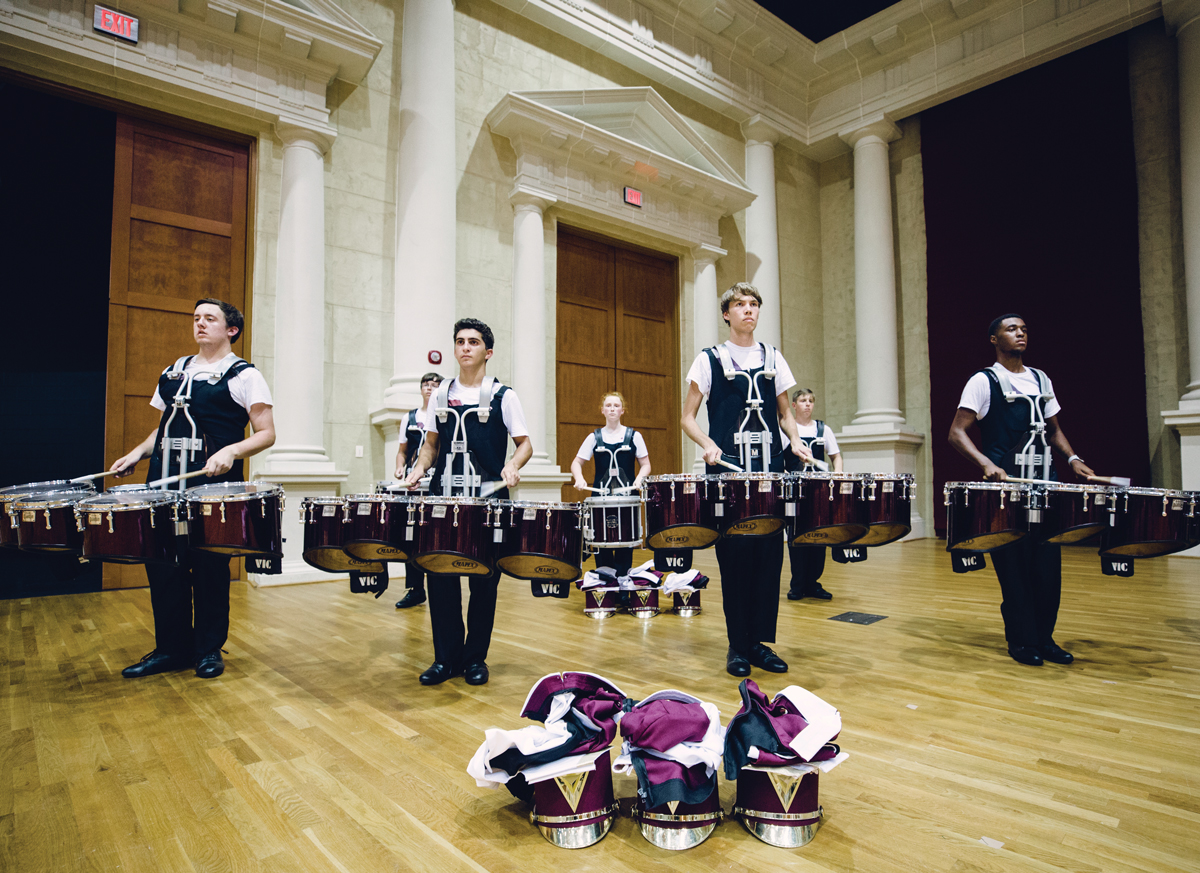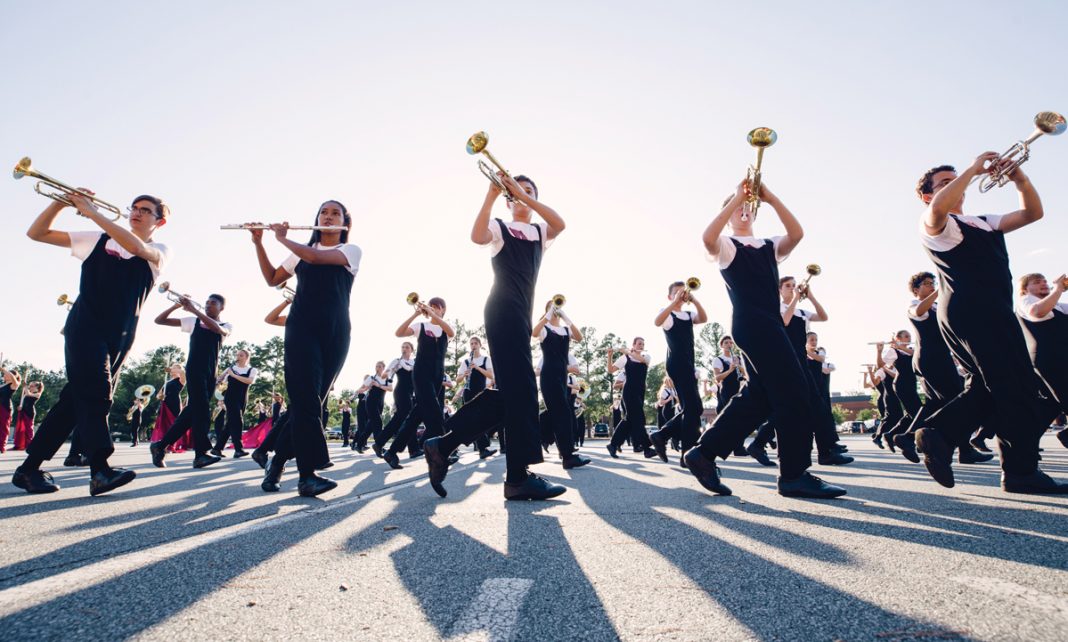PHOTOGRAPH BY RYAN GIBSON
“You like Beyoncé?”
It’s a 90-degree Friday night in September, and in front of some 4,000 high school football fans packed into bleachers for homecoming, band director James Thompson is asking what my favorite music is. He calls over to his assistant director on the platform in front of the band and issues a directive. She relays the message to the students via microphone. Within seconds, 28 rows of students swell with the blaring, opening brass riffs of “Crazy in Love.”
In between pop tunes and fight songs, the 165 members of the Lassiter Marching Trojan Band hang out, take selfies, and at one point, do the Macarena. But as the second quarter winds down and the sky darkens, the mood shifts. Adults in matching yellow polo shirts materialize on the sidelines in a buzzing swarm, dragging out xylophones and rearranging extension cords. (These are the roadies, the volunteer parents responsible for the band’s massive amount of equipment. Their motto, emblazoned on the back of those yellow shirts: “We Rack ’Em, Pack ’Em, and Stack ’Em.”)
Shepherded by four drum majors, students file out of the bleachers and down to the field, where they cloister off by section. The brass assemble near the sidelines; percussion congregates in the end zone underneath the goalpost. To the left of the bleachers in front of a chain-link fence, woodwinds huddle.

Photograph by Ryan Gibson
With their plum-colored shako caps placed carefully on the ground before them and instruments in hand, the woodwind players go through an eight-minute choreography of body bends, footwork drills, breathing exercises, and scales led by assistant director Kimberly Snyder. No one but Snyder speaks a word; the students are silent, composed, laser-focused.
Looking on, Alfred Watkins, the now-retired band director who led Lassiter’s marching band to two national championships during his 31-year tenure and whose name is now prominently displayed on the building just beyond the football field, turns to me, looks over his spectacles, and gestures toward the group with a smile: “That’s how you win championships.”
Belting out Queen’s “Bohemian Rhapsody,” they step onto the field in perfect formation, their oxblood plumes glinting in the stadium floodlights. The band moves seamlessly through a complex, coordinated series of movements like a murmuration of starlings, each half of the field marching sideways in symmetry toward the center, dissipating into tight circles and right angles, and, at one point, sprawling across 70 yards in one perfectly curved arc. After their performance, they stand to the side and play softly as the pastel taffeta ball gowns of the homecoming court swish across the turf. That night, the Lassiter football team lost to Wheeler by 25 points. For the band, it was just a warm-up.

Photograph by Ryan Gibson
On New Year’s Day this month, the students in the band will run through those same stretches, breathing exercises, and scales—only this time, it won’t be in preparation for stands full of friends and family, nor will it be on the turf of a high school football field. On January 1, the entire band will march the five-and-a-half-mile route of the 130th Tournament of Roses Parade alongside bands from Puerto Rico, Sweden, and Canada as this year’s Grand Marshal, Chaka Khan, leads the charge. Roughly a million people will watch from the sidelines, with many millions more watching on television. The performance will mark yet another accolade in a list of more than 100 earned throughout the band’s 37-year history: two national championships, a dozen regional championships, three appearances in the Macy’s Thanksgiving Day Parade, and soon, five performances before the Tournament of Roses.
“On that day, 40 million people will see us represent Marietta. More people will see you on that day than probably in your entire life.”
Thompson, whose father was a band director in Savannah for 21 years, joined Lassiter as an assistant director under Watkins in 2007 and took over eight years later. He knew the band’s reputation beforehand—in his field, most people do—but was floored by the resources and parental involvement available here. Eighty-three percent of seniors head to four-year colleges, and the curriculum offers some two dozen AP courses. Most students voluntarily pay about $1,100 annually to participate in band. According to U.S. News, only 8 percent of the student body receives free or reduced-price lunches. By contrast, at Thompson’s former school in Savannah, that number is 78 percent.
The total cost of the trip is expected to be about $600,000, a daunting total even in this affluent area of Cobb County. Band parents sell $10 raffle tickets for a Jeep Wrangler from Ed Voyles. There’s also an annual Christmas tree sale, a craft fair in November, and a mattress sale in the band room, not to mention Crowdrise and text message campaigns. Still, families end up paying for the difference.
The Tournament of Roses vets hundreds of applications and selects only 20. Georgia actually has a pretty good record of acceptance. In addition to Lassiter, Lithonia’s Martin Luther King Jr., Cobb’s Walton, and Central-Carroll high schools have all performed in recent years.
But the selection committee had rejected Lassiter’s application the year before, and only two weeks prior, the Macy’s Thanksgiving Day Parade had rejected them, too. Snyder, a former Marching Trojan herself, had been in Thompson’s office when the Pasadena area code appeared on his phone. Thompson took the call, put his face in his hands, and slumped into his chair. Did we get it? Snyder whispered. He looked at her and nodded. She began to cry.

Photograph by Ryan Gibson
Two weeks later, Thompson called the students out of their second-period classes. Prone to philosophizing, he delivered a brief soliloquy about the many thorns—the sweat, the conflict, the fatigue, the failure—one must endure in pursuit of life’s proverbial roses. Four minutes in, he finally said, “I’m here to tell you that the marching band has been selected for the Tournament of Roses Parade for 2019.” The room erupted in cheers. “On that day, 40 million people will see us represent Marietta,” he told the students. “More people will see you on that day than probably in your entire life.”
Two weeks after homecoming and a year after that speech, Thompson is in the band office, where seemingly every available surface is in use: a bookcase practically sagging with three-ring binders of drills and exercises, a bulletin board papered in pep rally schedules and performance calendars. The office door swings open every few minutes: a student meekly hands over an excuse note for missing an upcoming performance; a delivery person drops off garment bags; a Lassiter staffer inquires about the band’s tractor-trailer equipment rig, “T. Rex,” parked just outside of the building. A shaggy-haired kid enters the office, and Thompson pauses our conversation to gently reprimand the student, whose hair no longer fits inside his shako. “You don’t have to cut it. You can use bobby pins, but it can’t be like it was the other night,” Thompson says. “Our product depends on uniformity.”

Photograph by Ryan Gibson
“Hair should never hang below the shako” is just one line item among a litany of the band’s guidelines spelled out in a 42-page handbook. Pant legs must be hemmed with black thread so that they graze the second eyelet of the shoes without piling or puddling. Students aren’t allowed to wear jewelry or visible makeup when in uniform. Shoes must be polished, and gloves are to be washed after each wear. The handbook even specifies the type of hanger on which to store one’s jacket. (“Heavy duty! Don’t skimp.”)
That level of attention to detail is a high bar, especially considering that band is a no-cut extracurricular: The program is open to anyone enrolled in music classes at Lassiter. “Getting newcomers to understand ‘exact’ is always a challenge,” Thompson says. But that lesson begins on day one. The very first skill members learn is how to stand identically at attention, with feet angled at 45 degrees, chin slightly tilted 10 degrees upward, and hands held in loose fists with middle fingers grazing pant seams. A wedge is used to teach students the precise position of the feet.
Students study the mechanics of a single step: Heel first. Roll through the toes. Cross your ankles on the upbeat (the “and” between beats). During practice, band directors, drum majors, and section leaders monitor players, making minuscule adjustments.
Outside Thompson’s office, kids congregate in the cavernous band room. They come here not just for music courses, but also before school, after school, during lunch, in between classes. Surrounding them on all four walls, reaching up to the 20-foot ceiling, are shelves laden with 552 trophies spanning nearly four decades, their serrated silhouettes looming like skyscrapers.
On this afternoon, students in rumpled hoodies, Converse sneakers, and French braids file in and shrug off their backpacks in the corner. Soon, all eyes are on Thompson as he steps onto the small, raised platform and takes a seat in front of the class, trombone resting in his lap. Before cuing up a scale in Concert F, he instructs them: “Have the concept of what you want to sound like, then manifest it.” Behind him is a tearaway countdown calendar: 78 Days to Pasadena.

Photograph by Ryan Gibson
Inside Lassiter High School’s $1.5 million Alfred L. Watkins Band Building, it is impossible to ignore the band’s history. The corridor leading into the band room is plastered with plaques, framed competition photos, and proclamations signed by Zell Miller and Joe Frank Harris. Banners, commemorating the band’s appearances in past parades, dangle from the ceiling.
“People will come here, they’ll eat lunch in here, they’ll practice in here, and they come after school, even when there’s not practice,” says Molly Dunn, a soft-spoken senior who plays clarinet and serves as treasurer. She remembers how fortunate she felt to have that kind of home base in the overwhelming first few weeks as a freshman at Lassiter, which has more than 2,000 students enrolled. “Whenever you don’t have anywhere else to go, you can always come back to the band room.”

Photograph by Ryan Gibson
One could call it the band members’ second home, but truthfully, they spend nearly as much time here as in their actual homes. Students may devote upwards of 20 hours a week rehearsing and performing—surrendering many Saturdays to “9-to-9s,” or 12-hour practice marathons. That’s in addition to the 14- to 16-hour days they put in at band camp during July.
“We spend a majority of our lives here. We’re all at our best and worst together.”
Drills, or formations on the field, involve as many as 100 position changes, known as sets. “That’s a hundred opportunities to fail,” Thompson explains. It can take an entire season to master one show, and Thompson teaches it one movement at a time, over and over again, until each set and the transitions between are perfect, right down to the precise number of steps it takes to get from one hashmark to the next. Only after mastering the moves do they march with their instruments.
Thompson says his goal is to make the band sound perfectly balanced, as though they’re performing in a concert hall. Lassiter’s trademark, he tells me, is the complexity of their shows, both the maneuvers and the music. “We try to play stuff that’s difficult to play when you’re sitting down, much less when you’re on the move,” he says. “If we compete with another group, we might get [the scoring equivalent of] a B-plus, but we’re trying to do AP Calculus, and they’re trying to do general math.”
“We spend a majority of our lives here,” says Olivia Helmly, a tuba player. “We’re all at our best and worst together.” She reckons about 80 percent of her friends are in band. As for the remaining 20? “They support it, but they don’t really, like, get marching band.”
Helmly is also one of the band’s four drum majors, a leadership position earned after an extensive audition process that includes conducting a group piece, performing a solo, and demonstrating teaching and leadership skills. Drum majors arrive before everyone else and stay later. In order to direct fellow students, they carry a metronome on their person at all times, as is spelled out in the drum major audition pamphlet: Keeping steady time is your ultimate responsibility!
Outside these four walls, cultural tropes and misunderstandings of “band kids” persist—and yes, the students are well aware of those stereotypes. (The infamous and R-rated “one time at band camp” bit in American Pie came out before many of the current Lassiter band members were born.) “In the typical high school movies, band kids are seen as big nerds, but I’ve honestly never heard anyone disrespect us,” says Parker Franklin, another drum major. “Mostly I hear people say, ‘I don’t see how you guys do it.’”
Individual sections, which each meet once a week at 7 a.m. for practice in addition to their regular classes and rehearsals, forge their own tight-knit coteries. “A lot of sections tend to stay together,” explains Franklin, who hangs mostly with flutes, clarinets, and tubas.

Photograph by Ryan Gibson
Sections have their own T-shirts, wear certain colors to practice on certain days, and celebrate the end of every rehearsal with their own cheers. They also tend to attract, or perhaps cultivate, their own personalities. Helmly informs me that trumpets tend to think they’re always right, flutes are nitpicky perfectionists who “clean a lot,” and trombones like to clown around.
That phenomenon isn’t specific to Lassiter, either, according to Thompson. “It’s fascinating to me how, from program to program, those personalities kind of manifest themselves,” he says. Low brass players, he notices, tend to “go with the flow,” while double reeds are quirky and eccentric. Drummers are often the wild cards—the kids he has to keep an eye on whenever the band travels. As for saxophones? “They’re always cool,” says Thompson. “I mean, they just always are.” (At one point in our conversation, the band office door is left ajar, and I overhear a scrawny freshman in the band room exclaim to another: “Saxophone is lit.”)
In the often perplexing social minefield that is high school, marching band offers an instant tribe. Fellow bandmates are the kids you sit next to in class, partner with for group projects, eat lunch with in the cafeteria. At Alfred Watkins’s retirement party, there were 22 married couples who had met in his band. And when Snyder’s father passed away while she was a freshman flutist, Watkins, along with many of the band officers, attended his funeral.
Football or basketball players practice to become a team, but band members drill to become one player. The bond provides a safe place where adolescents on the brink of adulthood can discover whether they’re a woodwind or a horn, a percussionist, maybe even a saxophone. The product may depend on uniformity, but it’s a fine place to become an individual.
This article appears in our January 2019 issue.











![The North Carolina Museum of Natural Sciences’ newest exhibit is a [pre]historic first](https://cdn2.atlantamagazine.com/wp-content/uploads/sites/4/2024/04/DD-3-100x70.jpg)


